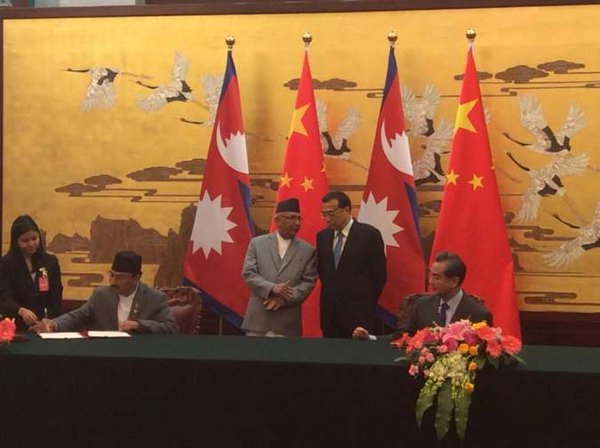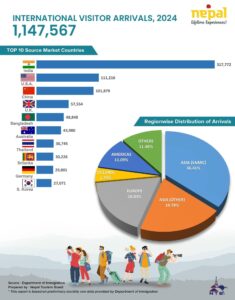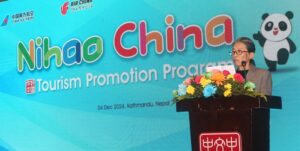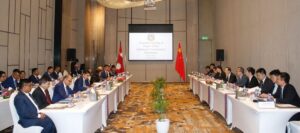Nepal and People’s Republic of China issue 15-point joint statement

TBN Desk –
Kathmandu : Nepal and People’s Republic of China have issued 15-point joint statement focusing on strengthening bilateral friendship and cooperation during the official visit of Prime Minister KP Sharma Oli.
Full Text of the Joint Statement between People’s Republic of China and Nepal :
1 – At the invitation of Premier Li Keqiang of the State Council of the People’s Republic of China, Rt. Hon. K.P. Sharma Oli, Prime Minister of Nepal paid an official visit to China from March 20 to 27, 2016. During the visit, Prime Minister Oli called on H.E. Xi Jinping, President of the People’s Republic of China, held official level bilateral talks with H.E. Li Keqiang, Premier of State Council of the People’s Republic of China and met with H.E. Yu Zhengsheng, Chairman of the National Committee of the Chinese People’s Political Consultative Conference. After his visit in Beijing, he will attend the Boao Forum for Asia Annual Conference 2016 and visit Xi’an of Shan’xi Province and Chengdu of Sichuan Province. He was accompanied by his spouse Mrs. Radhika Shakya, Hon. Mr. Kamal Thapa, Deputy Prime Minister and Minister for Foreign Affairs, Hon. Mr. Bishnu Prasad Paudel, Minister for Finance, Hon. Mr. Deepak Bohara, Minister for Commerce, Hon. Mr. Giriraj Mani Pokharel, Minister for Education, Mr. Bishnu Prasad Rimal, Chief Advisor to the Rt. Hon’ble Prime Minister, Members of Parliament, senior Government Officials, representatives from the private sector and media persons.
2- The two countries’ leadersexpressed satisfaction overremarkable achievements in cooperation of various fields since the establishment of diplomatic relationsbetween the two countries in 1955, and believed that the bilateral relationship maintained the momentum of healthy development on the basis of theFive Principles of Peaceful Coexistence, which sets a model of harmonious coexistence between countries of different size and social systems. The Chinese side welcomed the promulgation of the constitution in Nepaland regarded it asahistoric progress in the political transition of Nepal. The Chinese side sincerely hoped that Nepal could take this opportunity to realize its political stability and economic development.
The two sides noted that their countries are undergoing various forms of reforms, transformation and development. The China-Nepal relationship has reached a new height, and the two countries arefaced with more opportunities of development and prosperity. In this context, both sides will inherit and carry forward traditional friendship and deepen cooperation featuring equality and mutual-benefitto bring more benefits to both countries and their peoples.
3 -The two sides reiterated their firm commitment to respect each other’s independence, sovereignty and territorial integrity, respect and accommodate each other’s concerns and core interests. The Nepalese side reiterated its commitment to one China Policy. It firmly supports the efforts made by the Chinese side to uphold state sovereignty, national unity and territorial integrity, and does not allow any forces to use Nepalese territory for any anti-China or separatist activities. The Chinese side firmlysupports and respects Nepal’s own choice of social system and development path, and the efforts made by Nepalese side in upholding its sovereignty, independence, territorial integrity, national unity and stability.
4- Both sides believed that the high level contacts are of special importance to the development of bilateral relations. The two sides agreed to maintain the momentum of high level mutual visits, and have meetings between the leaders on the bilateral and multilateral occasions to share views on important issues of common interests. The two sides agreed to make full use of existing mechanisms, including the DiplomaticConsultations and the Joint Economic and Trade Committee meeting, to expand exchanges and cooperation between government departments, legislatures and political parties.
5 – As regardsNepal-China bilateral cooperation, bothsides agreed to synergize each other’s development planning, formulateappropriate bilateral cooperation programs and to carry out major projects under the framework of the Belt and Road Initiative. Both sides agreed to strengthen connectivity, further step up the land and air links and improve the land transport infrastructure. The Chinese side agreed to accelerate the feasibility study on the Araniko Highway Repair and Opening Maintenance Project and the Repair and Opening Maintenance Project of Syaphrubesi-Rasuwagadhi Highway, build the bridge over Karnali River at Hilsa of Pulan/Yari port. Thetwo sides also agreed to accelerate the upgradation of Kathmandu Ring Road1st phase by solving the pending issues and start the project feasibility study of 2nd phase, at appropriate time, and the Nepalese side will provide necessary cooperation to implement this project.The relevant authorities of both sides will exchange ideas and proposal on constructing cross border railways and railways network in Nepal, and support enterprises to start related preparatory work as soon as possible. Both sides exchanged views on facilitating Chinese investment in key areas including infrastructures by encouraging the Chinese investment in Nepal,as per the laws and regulation of Nepal.Both sides agreed to explore establishing cross border economic cooperation zones via existing frontier ports and to speed up opening up other frontier ports and trade pointsas mutually agreed upon. The two sides expressed satisfaction on the conclusion of Agreement on Transit Transport and directed the competentauthorities to immediately start negotiation to develop a protocol which will be an integral part of the Agreement.Both sides agreed to negotiate on the Agreement on Boundary Management System.
6 – The Chinese Government will continue to provide assistance to Nepal’s socio-economic development within its ability. The Chinese side will implement the 3 billion RMB grant assistance from 2016 to 2018 to support the post disaster reconstruction of Nepal, to carry out 25 key projects in areas covering infrastructure construction, recovery of people’s livelihood in quake-stricken areas of northern Nepal, repair of cultural and historic sites, capacity building in disaster prevention and control as well as medical and public health cooperation.
The Chinese side agreed to provide more than 32,000 sets of household solar-power generation system to Nepal, to build small-size education and public health facilities in several selected locations over Nepal, and to enhance cooperation on disaster preparedness and mitigation.The Chinese side agreed to carry out Rain Water Harvesting Project and other livelihood projects in Nepal to improve the living standard of the local people.The Chinese side will further enhance cooperation to the Nepalese side for the infrastructure development as well as social and economic development of the people residing in the bordering districts of Nepal and China.
7 – In view of the trade deficit of Nepal, the Chinese side will seriously consider to provide the enhanced market access to tradable products of Nepal as contained in the list recently provided by Nepal. The two sides agreed to start the joint feasibility study of China-Nepal Free Trade Agreement and conclude the study at an early date.The Chinese side encourages local government, Chinese enterprises and social groups to tap the potential with the Nepalese side on production capacitycooperation and economic and trade cooperation zones building and strengthen cooperation in areas that Nepal has resources and advantages, such as construction materials, water conservationand hydro-power, and organic agriculture.
8 – Both sides agreed to conclude a commercial deal on the supply of petroleum products from China to Nepal. In this context, they encouraged companies to speed up negotiations and concerned agencies to study providing supporting policies on issues of pricing, taxation, transportation, quality control and customs and frontier formalities.The Chinese side agreed to build oil storage facilities for Nepal, and will send experts to Nepal to carry out feasibility study on oil and gas resources research. The two sides agreed to establish a Dialogue Mechanism on Energy Cooperation to facilitate the long term planning of cooperation in this area, including trans-border power grid, hydro-power and solar power, etc. The Nepalese side agreed to take necessary steps to facilitate Chinese enterprises and their investment in Nepal.
9 – The two sides agreed to strengthencooperation between the law enforcement agencies of the two countries through exchange of information, capacity building and training in this field. Both sides agreed to negotiate Treaty on Mutual Legal Assistance in Criminal Matters and Treaty on Extradition, in order to strengthen cooperation on the administration of border areasand fight against illegal border crossing and transnational crimes.
10- The Chinese side welcomed the decision of the Government of Nepal to establish Consulate General of Nepal in Guangzhou, and also agreed to earnestly study Nepal’s proposal of establishing the Consulate General of Nepal in Chengdu. The agreements on the establishment of sister-city relationships between Yusu-Pokhara, Shannan-Bhaktapur and Chengdu-Kathmandu were welcomed by both sides. The Chinese side encourages the Tibet Autonomous Region as well as Sichuan, Yunan and Qinghai and other provinces to enhance cooperation as defined by the Government of Nepal.
11 – Both sides agreed to support each other’s tourism promotion activities in their respective countries to enhance people-to-people contacts. To support the recovery of tourism in Nepal, the Chinese side is willing to provide Chinese language training in Nepal for 200 Nepalese tourism professionals in the coming five years, and encourage Chinese enterprises to invest in Nepal’s tourism facilities. The Chinese side is willing to provide around 400 training opportunities inhuman resources development and more government scholarships this year to the Nepalese side and welcome more Nepalese students to pursue higher education in China through other channels or programs. The Chinese side will hold the Seventh China Festival and Second Kathmandu Cultural Forumwithin this year, and further enhance China-Nepal cultural cooperation through the platform of Chinese Cultural Centre in Nepal.The Nepalese side is willing to provide necessary facilities and assistance in this regard.
12-The two sides agreed to further promote cooperation in multilateral forums including in the United Nations on issues of mutual interests. They believed that cooperation among the developing countries on climate change, energy, food security, etc. will enhance and consolidate their solidarity and promote their collective strength in shaping global development agenda.The two sides positively view and support each other’s participation in the regional cooperation process, and agreed to enhance coordination and cooperation within SCO, SAARC and other regional cooperation mechanisms within the agreed frameworks and guidelines.
13 – The Chinese side agreed to provide financial support on preferential terms for Pokhara Regional International Airport. The Nepalese side requested the Chinese side to provide assistance for the preparation of Detailed Project Report (DPR) and construction of a dedicated two lanes Kimathanka-Khandbari-Dhankuta Road and upgrade Kathmandu Ring Road 2nd Phase, to provide financial and technical support for the feasibility study and the preparation of DPR of the proposed Rashuwagadi-Kathmandu and Kathmandu-Pokhara-Lumbini Railway Project, to take up 434 MW Arun-Kimathanka Hydro Power Project and 400 KV Cross-Border Transmission Lines Project atRashuwagadi-Kerung border point and construct 132KV Double Circuit Transmission Lines Monopole Structure around Kathmandu Ring Road. The Nepalese side also hoped that the Chinese side could provide assistance for the establishment of the Madan Bhandari Institute of Technology (MBIT) in Nepal and expansion of the Civil Service Hospital.The Nepalese side requested that these projects be taken up as priority ones and funding arrangements will be sought from various sources, and the Chinese side is willing to study earnestly after the Nepalese side’s providing of Detailed Project Proposals of above-mentioned projects.
14 – In order to facilitate trade, tourism and investment between the two countries, the Chinese side supports Chinese-funded banks to open branches inNepal in accordance with relevant policies and regulations. In this context, the Nepalese side is expected to provide policy and regulation facilities for Chinese funded banks to enter in to Nepalese market.
15 -Prime Minister Oli expressed his appreciation for the warm and friendly hospitality extended by the Chinese side, and extended invitation to the Chinese leaders to visit Nepal within this year. The Chinese leaders expressed thanks for the invitation and agreed to visit Nepal at mutually convenient dates which will be worked out through the diplomatic channels.
During the visit, the two sides signed agreements covering the areas of free trade, transit transport, connectivity, financial cooperation, etc.
Beijing,March 23, 2016














